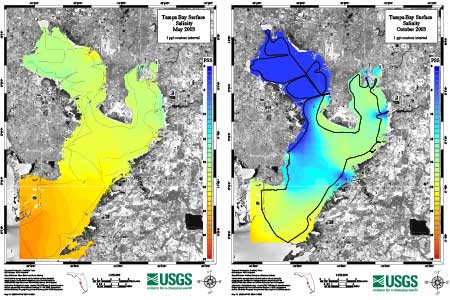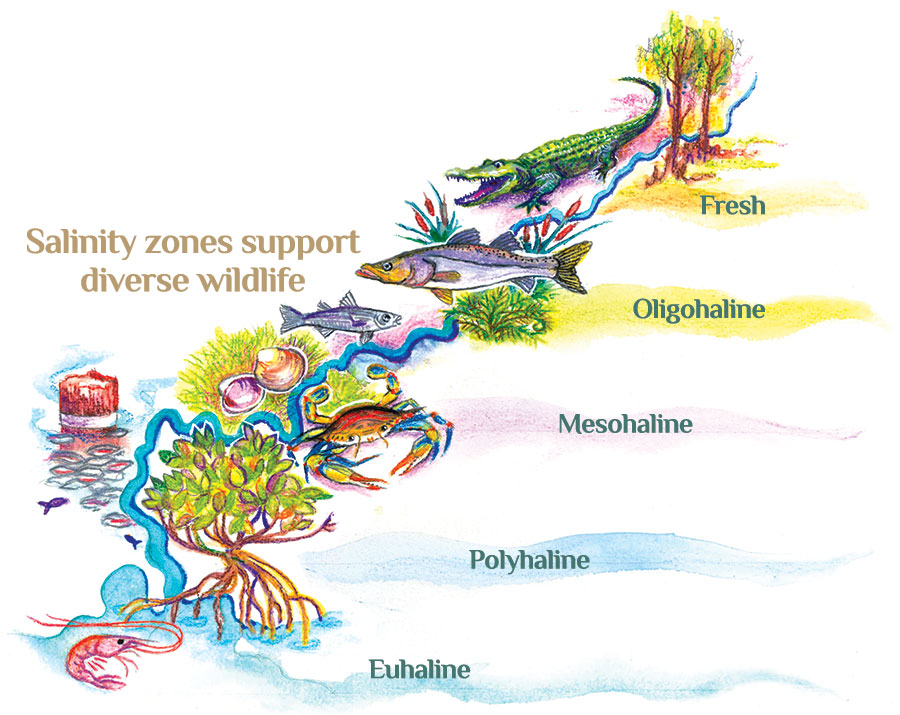[printfriendly]Salinity zones support diverse wildlife
[easy-media med=”1216″ size=”300,400″ align=”right”]Those of us who enjoy being outdoors on bay area waterways have noticed that the seasonal shifts in flora and fauna aren’t limited to the landside areas – river populations change as well. In northern climates, snow is the “white stuff” usually associated with seasonal change, but in healthy Florida tidal rivers, salt is the ingredient that drives annual fluctuations.From my vantage point on the upper reaches of the Hillsborough River estuary (where tidal waters reach up to the Rowlett Park Dam), summertime means alligators, turtles and gar fish. But come the year-end holidays, the winter tourists arrive led by the mullet and manatees. Last spring I even saw a pair of dolphin merrily chasing fish upriver. I was surprised to discover how seasonal saline shifts are the primary drivers behind this ever-changing animal ecotourism.
WHAT COMES NATURALLY
Due to large changes in seasonal rainfall, Tampa Bay’s tidal rivers contain varying amounts of fresh water, brackish water, and higher salinity bay water during the year. Rivers also carry nutrients and detritus from decaying vegetation in the watershed downriver. At the same time, tidal action from the bay sends salt water up the rivers filled with plankton and various chemical constituents. As these waters combine, the salinity ranges create distinct ecological zones in rivers and creeks (see main illustration).
Salinity is measured in parts per thousand (ppt), which is approximately the number of grams of salt in a kilogram of water. Ranging from a briny seawater (euhaline), to increasingly fresher water environments (polyhaline > mesohaline > oligohaline > fresh water), salinity strongly influences the composition of the wetland species, plankton, benthic invertebrates, crabs, and so on up the food chain.
However, rather than seeing these biological zones as a stationary map along the river, it’s better to imagine them as a shifting mosaic of communities based on gradients of salinity, nutrients, dissolved oxygen, and flow from the bay or nearby uplands.
Salinity zones shift in response to variations in seasonal rainfall and streamflow, with extreme variations occurring during floods and drought. During the rainy season, robust amounts of fresh water flush through the river and surrounding estuaries. Sea water at the mouth of a river can become so diluted that it is frequently mesohaline, or sometimes even oligohaline during periods of very high freshwater flow.
Conversely, during a late-spring drought, the upper reaches of a tidal river, which are normally fresh, can develop enough salinity to also be considered a mesohaline environment (see seasonal maps of Upper Tampa Bay).
FOLLOW THE FOOD

What happens when biological activity in salt and fresh water come together is what makes an estuary so productive. When a freshwater river reaches a salty tidal influence, the current slows down and the organic detritus it has been carrying drops to the river bottom. This nutrient-rich detritus feeds phytoplankton populations which serve as the base of a food web that attracts larger invertebrates such as crabs and shrimp, and the juvenile stages of a wide variety of estuarine-dependent saltwater fish.
The species comprising this benthic buffet change on the trip upriver as saltiness decreases. In fact, many invertebrates, including several bivalves (clams, mussels and oysters) and gastropods (snails), have such characteristic salinity ranges they are regarded by scientists as indicators of habitat shifts. As the edges of the saline zones move with the tidal influx, opportunistic mature snook and mullet move far upstream to feed. Later, when the tide goes back out, their counterpart freshwater species arrive. The bass and gar come downstream looking for food in oligohaline areas.
[su_pullquote align=”right”]“The cure for anything is SALT water — tears, sweat, or the sea.”–Isak Dinesen[/su_pullquote]The juveniles of many estuarine-dependent fishes, including snook, mullet, tarpon, red drum and bay anchovy, also migrate to zones with lower salinity — not only because food is more plentiful, but also because some of their most dangerous predators are not as abundant in the low-salinity waters.
Organisms that can withstand a wide range of salinities are referred to as euryhaline. Stationary oysters use this strategy to avoid becoming a meal for stone crabs and oyster drills. Typically, oysters are found in upper mesohaline and polyhaline zones clinging to mangrove roots or as reefs on the river bottom. Here, these filter feeders thrive safely in a food-rich estuarine environment, where the widely varying salinity reduces their exposure to predators and parasites that occur in more stable, higher-salinity environments.
Manatees also use habitats in both rivers and the bay. During the dry season, the estuary becomes more salty, so salinity at the mouths of the rivers becomes more like the bay itself. Manatees need fresh water to drink. The sharp rise in salinity along the coastline drives them upstream seeking fresher water. Typically, they will journey upriver at least once a week during the dry season.
Manatees also use the saline gradients of rivers to keep warm in winter. During cold snaps, there is often a sharp boundary between the surface layer of cool fresh water and the layer of warm salt water trapped below. Fresh water is lighter than salt water and can flow over it, forming a sharp interface called a halocline. When haloclines are present during cold periods, the freshwater layer can act like a blanket, trapping pockets of warm salty water on the bottom and preventing the rapid heat loss that endangers manatees.
Plants that are highly tolerant of salt are called halophytes. A mangrove is a good example. Contrary to popular belief, mangroves don’t require salt water to grow. Instead, they use their ability to remove salt from water to help compensate for their slow growth pattern. By taking advantage of an environment that poisons faster-growing species, mangroves are able to thrive. However, as soon as the water salinity stabilizes in the mesohaline range, other plants move in and squeeze out the mangroves.
POPULATION IMPACT
When a river is charged with fresh water, its flow increases and the phytoplankton in the estuary are washed downstream as part of nature’s balance. The biologically active footprint of the estuary area can increase due to the higher volume of water in the river, which typically becomes much wider as it approaches the bay. But, when the river’s flow drops, the phytoplankton move upstream with the higher saline waters. If the drop in flow is substantial, the productive area of the estuary area can decrease when there is less low- and medium-salinity water in the system.
A good example is the Hillsborough River, which begins in the Green Swamp, and has tributaries throughout Pasco and Hillsborough counties. Prior to 1916, the rivers’ tidal mix of fresh and salt water made it a fertile nursery for marine life. Then nearly a century ago, the Hillsborough River was impounded to generate electricity and capture fresh water for the growing city. As water use increased, there were periods of no flow through the dam, resulting in mesohaline waters at the base of the dam in the dry season, instead of the natural gradient of fresh water mixed with tidal flows.
As a result, in 2007, the Southwest Florida Water Management District (SWFWMD) mandated minimum flows for the Lower Hillsborough River that create a zone of oligohaline water below the dam in the dry season. The ecological importance of low-salinity flows in tidal rivers has been amply documented. Today, water managers set minimum flow standards that measure salinity to determine how much fresh water can be safely removed without damaging the productivity of a river. On the Alafia River, another important tributary to Tampa Bay and the source of water for Tampa Bay Water’s main reservoir, the rate of freshwater flow to the tidal river cannot be reduced by more than 19% on any day depending on the total flow in the river.
Barriers in a tidal river also can restrict and reduce biological productivity in tidal river systems. In 2012, the Tampa Bay Estuary Program and SWFWMD produced a comprehensive inventory of salinity barriers on tidal tributaries flowing into Tampa Bay. The report identified a total of 344 potential barriers, crossings and water control structures on tidal tributaries and rivers throughout the region. The vast majority of the barriers were roadways. The inventory went further and prioritized the structures for modification over the coming years.
In past years, discussions over restoration and preservation of the normal tidal systems in rivers have sometimes become heated. The expense and demand for fresh water routinely competes with the balance nature intended.
I, for one, am grateful to see the ecological improvements that the return of flow has brought to the Hillsborough River. Apparently, the City of Tampa agrees since it continues to make investments that showcase the river. Recently, as he officially opened the Sulphur Springs pump station to send more water over the Rowlett Park Dam, Mayor Bob Buckhorn said it well: “A healthy river equals a healthy city.”
Now that’s an idea worth its salt.
[su_note note_color=”#d2f4e4″]Experiment. Mangroves don’t need salt water to survive. Take one of the long red mangrove seeds and put it outside in a glass of fresh water. Over the next few months it will sprout and eventually grow into an attractive outdoor plant. All it needs is water.[/su_note]Article & Illustrations: Sigrid Tidmore. Science Advisor: Michael S. (Sid) Flannery, chief environmental scientist, Southwest Florida Water Management District
[su_divider]